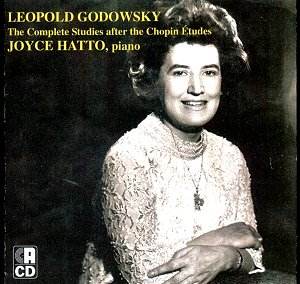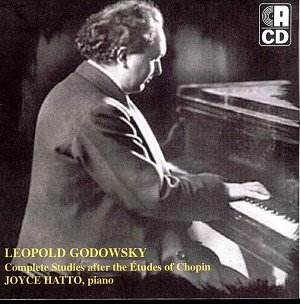|


These discs have been
withdrawn from sale as they may not feature
Joyce Hatto after all.
They are thought to be performed by Carlo Grante
from the Altarus label
|
Leopold
GODOWSKY (1870-1938)
The Complete Studies on Chopin’s Etudes
1. No. 1, Op. 10 No. 1 (1st version), C major
[2'09]
2. No. 2, Op. 10 No. 1 (2nd version), D flat
major, left hand [2'59]
3. No. 3, Op. 10 No. 2 (1st version), A minor,
left hand [1'40]
4. No. 4, Op. 10 No. 2 (2nd version), A minor,
'Ignis fatuus' [2'01]
5. No. 5, Op. 10 No. 3, D flat major, left hand
[4'47]
6. No. 6, Op. 10 No. 4, C sharp minor, left
hand [2'42]
7. No. 7, Op. 10 No. 5 (1st version), G flat
major [1'43]
8. No. 8, Op. 10 No. 5 (2nd version), C major
[1'59]
9. No. 9, Op. 10 No. 5 (3rd version), A minor,
'Tarantella' [2'30]
10. No. 10, Op. 10 No. 5 (4th version), A major,
'Capriccio' [2'11]
11. No. 11, Op. 10 No. 5 (5th version), G flat
major [2'00]
12. No. 12, Op. 10 No. 5 (6th version), G flat
major [1'52]
13. No. 12a, Op. 10 No. 5 (7th version), G flat
major, left hand [2'30]
14. No. 13, Op. 10 No. 6, E flat minor, left
hand [3'37]
15. No. 14, Op. 10 No. 7 (1st version), C major,
'Toccata' [1'57]
16. No. 15, Op. 10 No. 7 (2nd version), G flat
major, 'Nocturne' [3'17]
17. No. 15a, Op. 10 No. 7 (3rd version), E flat
major, left hand [2'22]
18. No. 16, Op. 10 No. 8 (1st version), F major
[3'18]
19. No. 16a, Op. 10 No. 8 (2nd version), G flat
major, left hand [3'56]
20. No. 17, Op. 10 No. 9 (1st version), C sharp
minor [2'56]
21. No. 18, Op. 10 No. 9 (2nd version), F minor,
Imitation of Op. 25 No. 2 [3'04]
22. No. 18a, Op. 10 No. 9 (3rd version), F sharp
minor, left hand [6'11]
23. No. 19, Op. 10 No. 10 (1st version), D major
[4'39]
24. No. 20, Op. 10 No. 10 (2nd version), A flat
major, left hand [2'38]
25. No. 21, Op. 10 No. 11, A major, left hand
[3'18]
26. No. 22, Op. 10 No. 12, C sharp minor, left
hand [3'11]
27. No. 23, Op. 25 No. 1 (1st version), A flat
major, left hand [3'06]
 Joyce Hatto (piano)
Joyce Hatto (piano)
Rec. The Concert Artist Studios, Cambridge,
4th September and 10th
October 2004
 CONCERT ARTIST/FIDELIO RECORDINGS CACD 9147-2
[79.00]
CONCERT ARTIST/FIDELIO RECORDINGS CACD 9147-2
[79.00]
1. No. 24, Op. 25 No. 1 (2nd version), A flat
major, like a piece for 4 hands [2'36]
2. No. 25, Op. 25 No. 1 (3rd version), A flat
major [2'56]
3. No. 26, Op. 25 No. 2 (1st version), F minor
[3.43]
4. No. 27, Op. 25 No. 2 (2nd version), F minor,
'Waltz' [2'33]
5. No. 28, Op. 25 No. 2 (3rd version - A), F
minor [2'32]
6. No. 28, Op. 25 No. 2 (3rd version - B), F
minor [2'46]
7. No. 28a, Op. 25 No. 2 (4th version), F sharp
minor, left hand [2'38]
8. No. 29, Op. 25 No. 3 (1st version), F major
[2'22]
9. No. 30, Op. 25 No. 3 (2nd version), F major,
left hand [2'30]
10. No. 31, Op. 25 No. 4 (1st version), A minor,
left hand [2'13]
11. No. 32, Op. 25 No. 4 (2nd version), F minor,
'Polonaise' [6'13]
12. No. 33, Op. 25 No. 5 (1st version), E minor
[3'34]
13. No. 34, Op. 25 No. 5 (2nd version), C sharp
minor, 'Mazurka' [2'42]
14. No. 35, Op. 25 No. 5 (3rd version), B flat
minor, left hand [4'24]
15. No. 36, Op. 25 No. 6, G sharp minor [2'20]
16. No. 38, Op. 25 No. 8, D flat major [1'25]
17. No. 39, Op. 25 No. 9 (1st version), G flat
major [0'59]
18. No. 40, Op. 25 No. 9 (2nd version), G flat
major, left hand [1'24]
19. No. 41, Op. 25 No. 10, B minor, left hand
[4'25]
20. No. 42, Op. 25 No. 11, A minor [4'33]
21. No. 43, Op. 25 No. 12, C sharp minor, left
hand [3'21]
22. No. 44, Méth. M-F No. 1, F minor,
left hand Moscheles 1 [1'33]
23. No. 45, Méth. M-F No. 2 (1st version),
E major Moscheles 2 First Version [4'04]
24. No. 45a, Méth. M-F No. 2 (2nd version),
D flat major, left hand Moscheles 2 Second
Version [2'03]
25. No. 46, Méth. M-F No. 3, G major
'Menuetto' Moscheles 3 Sole Version [3'45]
26. No. 47, Op. 10 No. 5 and Op. 25 No. 9, G
flat major, 'Badinage', 2 studies combined [1'39]
27. No. 48 Op. 10 No. 11 and Op. 25 No. 3, F
major, 2 studies combined [3'29]
 Joyce Hatto (piano)
Joyce Hatto (piano)
Rec. The Concert Artist Studios, Cambridge,
1st September and 10th and 11th October
2004
 CONCERT ARTIST/FIDELIO RECORDINGS CACD 9148-2
[77.58]
CONCERT ARTIST/FIDELIO RECORDINGS CACD 9148-2
[77.58]
|
Error processing SSI file
|

